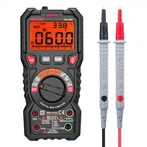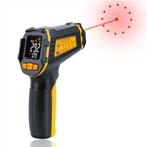ow to use a multimeter to measure inductance
How to measure inductance with a digital multimeter
The inductive element is a coil formed by winding an enameled wire on a magnetic sheet (or a magnetic ring), and then a device formed by surface encapsulation.
In the maintenance of notebook computer motherboards, the "on-the-road test" method is generally used to judge the quality of the inductive components.
Detection method:
Step 1: Check the choice of gear
Since the DC impedance of the copper wire of the inductor coil is very small, it is basically close to straight-through. Therefore, when testing the inductive element with a digital multimeter, according to this characteristic, select the lowest gear of the resistance, and judge whether it is good or bad by measuring its on/off method.
Turn the digital multimeter to the gear marked with the "n" symbol, and select the range gear of "diode with buzzer".
Step 2: Detection Operation
In the "passive" state after the mainboard of the notebook computer is powered off, use the two test pens of the digital multimeter to contact the solder joints at both ends of the inductive element respectively. Since the inductive element has no positive and negative points, the test pens are not divided into positive and negative. During the operation of this step, the time for the test lead to contact the solder joints at both ends of the inductive element should not be too short, otherwise it is easy to cause misjudgment.
Step 3: Observe the test results to make judgments
If the reading displayed on the LCD is a stable "0" or very close to "0", and the buzzer keeps ringing during the test, the tested inductive component is good; if the reading shows an overflow symbol " 1" (ie "∞"), it means that the inductive element has been broken and damaged; if the number displayed on the LCD screen flickers during the test; the buzzer does not sound when it rings, in most cases it is the solder joint of the component If there is a phenomenon of virtual welding or de-soldering, it should be repaired and then tested.
The above three situations are relatively common in maintenance testing, and there are two more special situations that need to be specially explained, such as F:
First, if the reading of the digital meter is too large to about 10n or more than 10Ω, even if the buzzer is always sounding, it cannot be judged that the tested inductive element is good.
Because the impedance of all inductive components on the notebook computer motherboard cannot reach about 10Ω: the flat energy storage inductors, transformers, etc. used in the power circuit with large power consumption and large current, the copper wire of the winding is thicker, and the impedance Very low; small size chip inductors used in power circuits or signal circuits with low power consumption and low current, although the copper wire of the winding is very thin, but the number of turns is small, the length is short, and the impedance is also low.
Therefore, the detected reading of about 10Ω or more is not the normal impedance value of the inductive element. It may be that the measured inductance has been broken, and the reading is the impedance value of other parallel circuits; it may also be that the measured inductance has been burned and broken, and the reading is the turn The contact resistance value formed by the short circuit between them.
Second, if during the detection process, the buzzer stops abruptly after the test pen touches the solder joints at both ends of the inductor for a short time, which usually occurs in power circuits with large currents. This phenomenon occurs not only because the inductance element has been broken, but also indicates that there is a serious short circuit (grounding) phenomenon in the circuit at one end of the inductance. The short-term sound of the buzzer is caused by the voltage across the test leads charging the large-capacity electrolytic capacitor in the circuit instantaneously. of.
Therefore, when detecting the inductive element, the time for the test lead to contact the solder joints at both ends of the inductive element cannot be too short.






